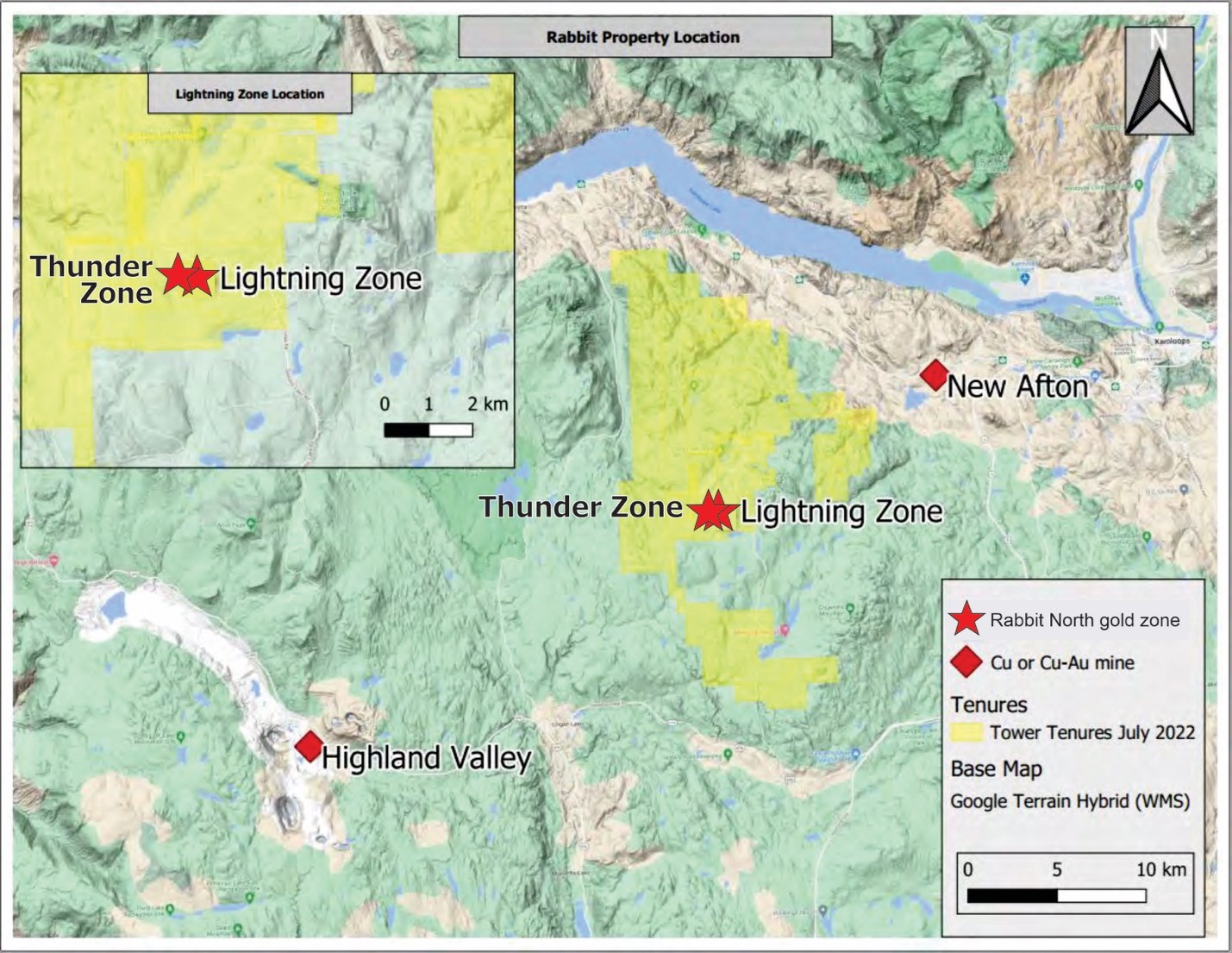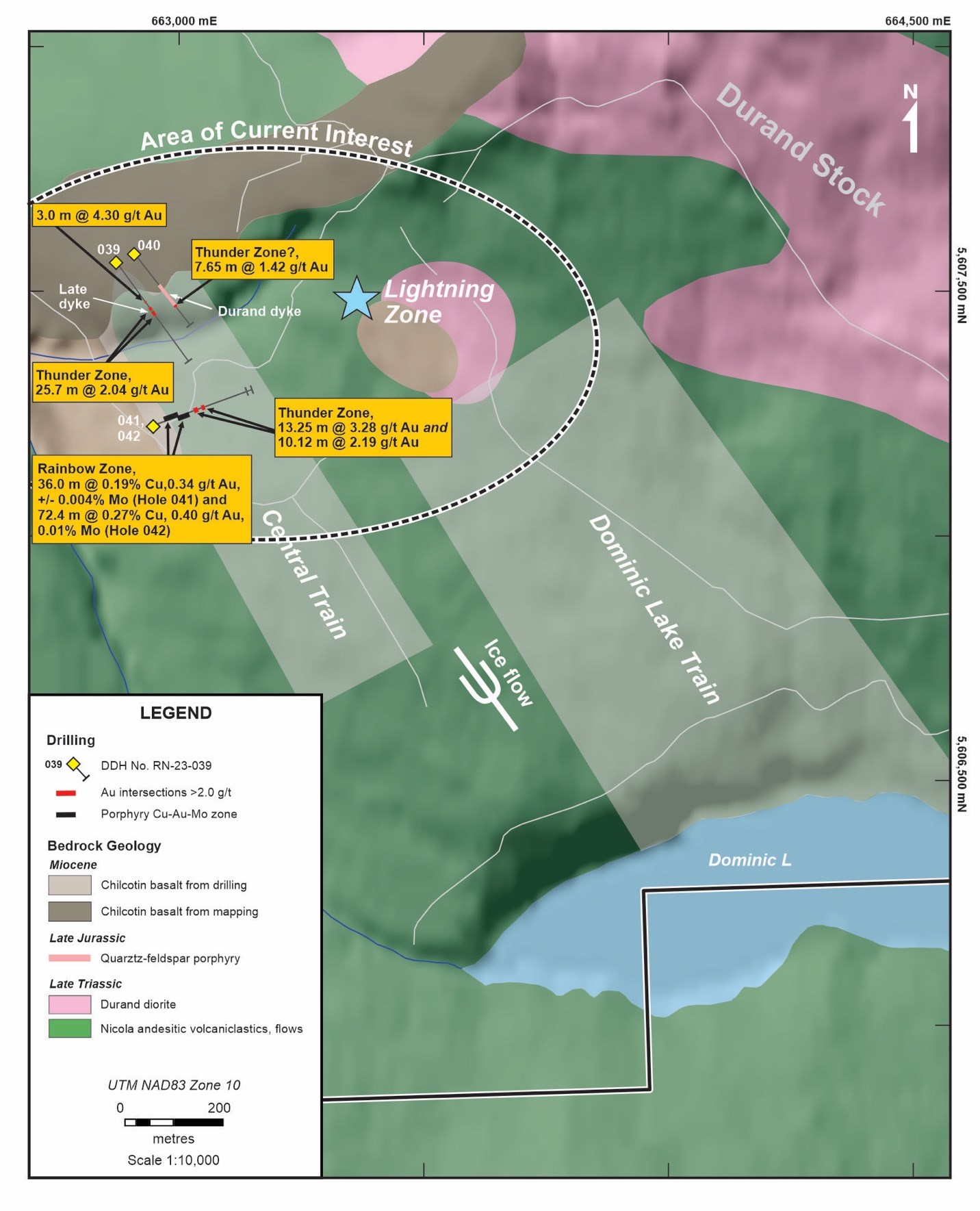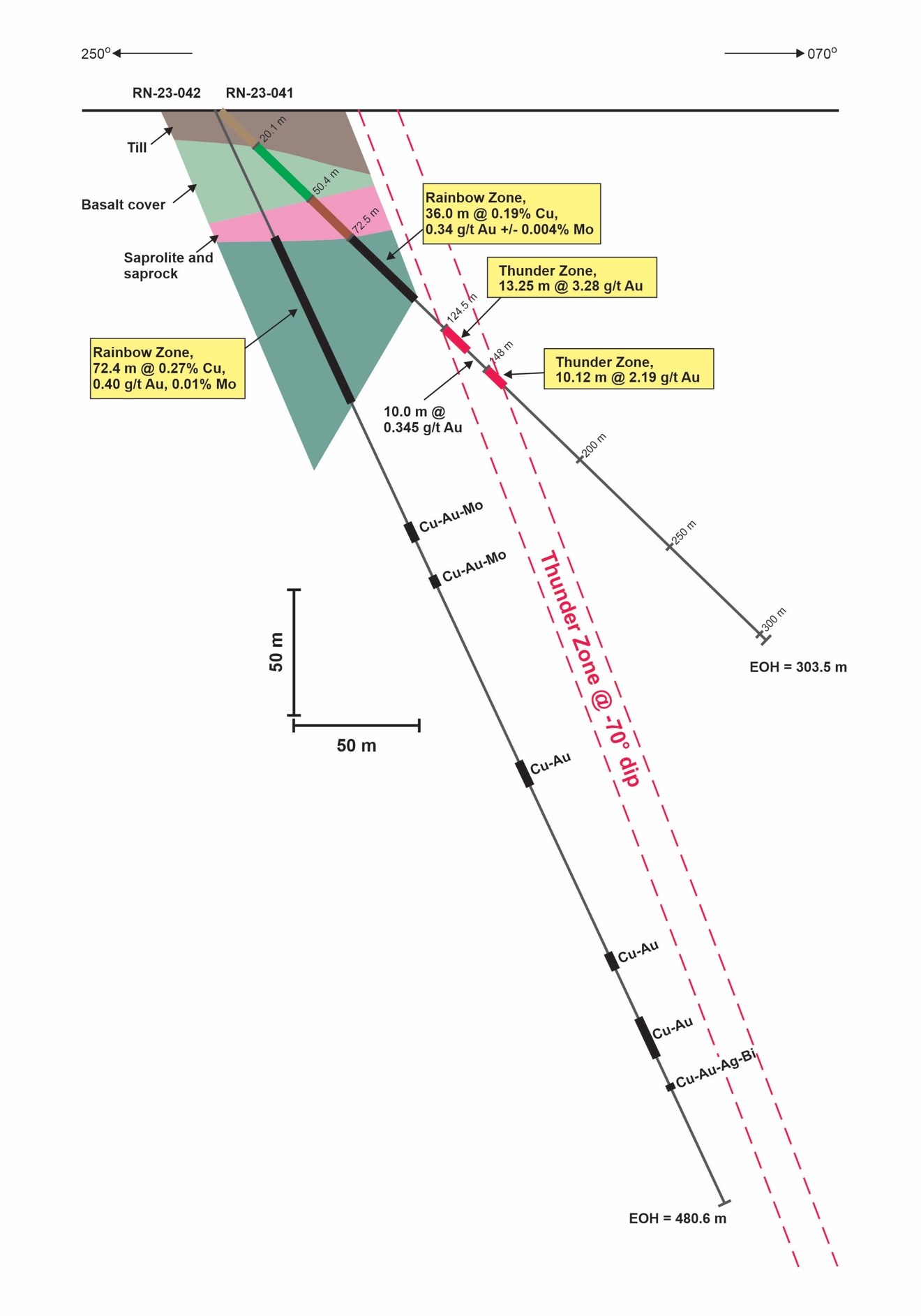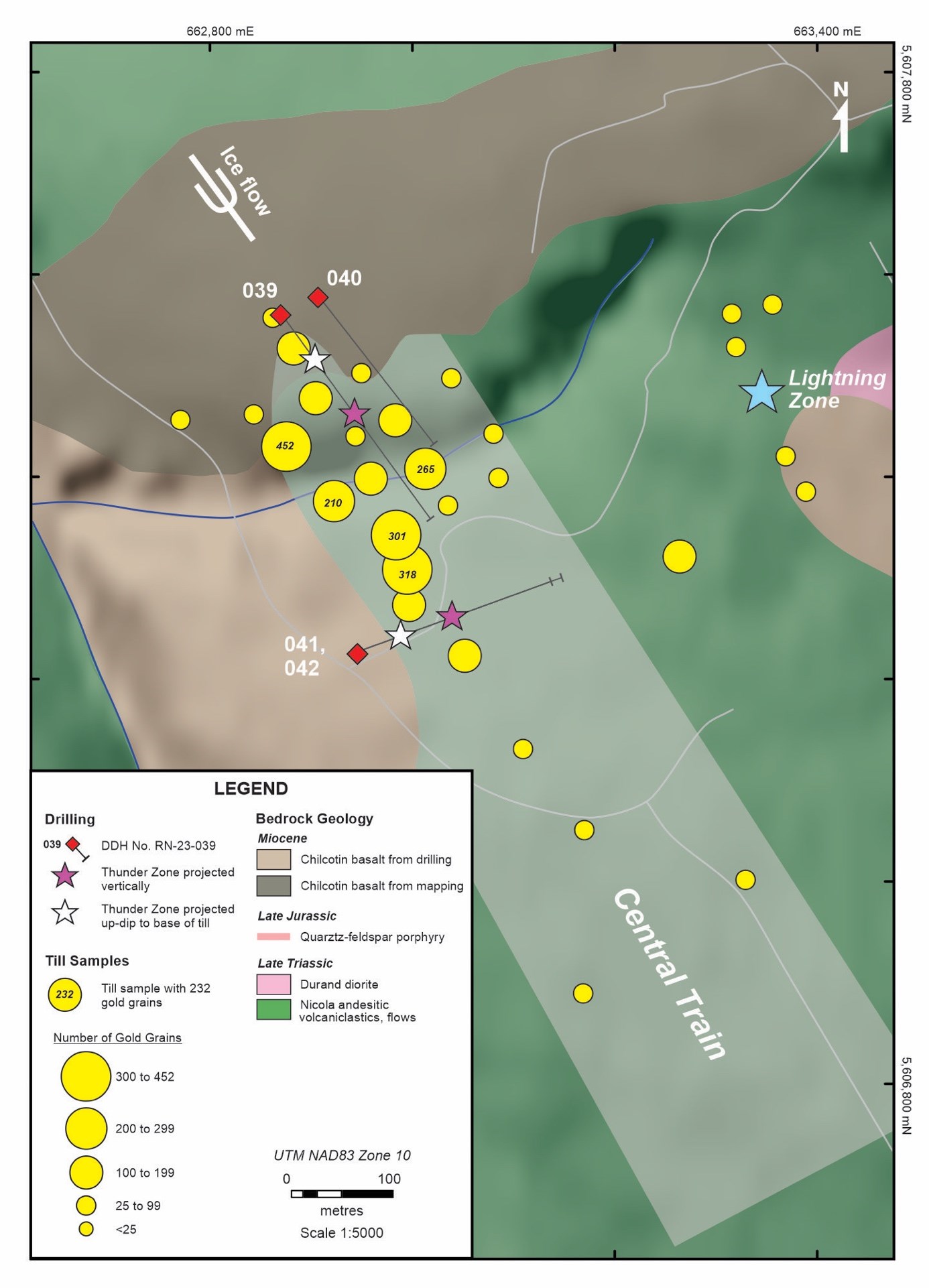Hole Drilled Too Steeply to Reach Deeper Thunder Au Zone, Finds Significant Additional Porphyry Cu-Au Mineralization Between Zones
Vancouver, British Columbia--(Newsfile Corp. - April 20, 2023) - Tower Resources Ltd. (TSXV: TWR) ("Tower" or the "Company") is pleased to report that assays received from Hole 042 on the Company's Rabbit North property near Kamloops, British Columbia, between New Gold's New Afton underground Cu-Au mine and Teck's Highland Valley open pit Cu-Mo mine (see Fig. 1), show that the new, near-surface Rainbow Cu-Au-Mo Zone that was just discovered in Hole 041 (see press release from April 5, 2023) increases in both grade and thickness to the west. A 72.4 m section beneath thin basalt cover (see Figs. 2, 3) averages 0.27% Cu, 0.40 g/t Au and 0.01% Mo, or 0.57% Cu-equivalent (see Table 1).
Significance of the Increase in Grade of the Rainbow Zone in Hole 042
The 0.57% Cu-equivalent grade of the 72.4 m long intercept of the Rainbow Zone in Hole 042 compares very favourably with the reported reserve grades of three of the largest, currently producing open-pit porphyry Cu±Au±Mo mines in BC (see Table 1) - Highland Valley @ 0.35% Cu-equivalent, Red Chris @ 0.53% and Mt. Milligan @ 0.48%. In addition, the Rainbow Zone is very close to surface (see Fig. 3); it has the best combination of grade and depth of any of the known porphyry Cu-Au occurrences on the property.
| Deposit | Company | Cu % |
Au g/t |
Mo % |
Cu- Equivalent %* |
Category | Data Source |
| Rainbow Zone | Tower | 0.27 | 0.4 | 0.01 | 0.57 | 72.4 m DD intersection | DDH RN23-42 |
| Highland Valley | Teck | 0.31 | 0 | 0.008 | 0.35 | Proven & probable reserves | Mining Data Solutions |
| Red Chris | Imperial Metals | 0.36 | 0.27 | 0 | 0.53 | Proven & probable reserves | 43-101 Technical Report, 2021 |
| Mt. Milligan | Centerra Gold | 0.37 | 0.18 | 0 | 0.48 | Proven & probable reserves | 43-101 Technical Report, 2021 |
| *Based on Cu @ US $4.00/lb, Au @$1800/oz and Mo @ $20.00/lb | |||||||
Table 1 - Grade of the Rainbow Zone in Hole 042 relative to those of selected BC porphyry Cu±Au±Mo deposits.
Potential Extent of the Rainbow Zone
Holes 041 and 042 were drilled from the same pad at the same 070° azimuth (see Fig. 2) but at flat (045°) and steep (065°) dips, respectively (see Fig. 3). The increase in thickness of the Rainbow Zone in Hole 042 indicates that the holes intersected the eastern edge of the Rainbow Zone and that the eastern contact dips to the west at ~60°. The Rainbow Zone is hidden by basalt cover, explaining why it was not discovered earlier. The basalt extends much further southwest than previously mapped (see Fig. 2) and the Rainbow Zone remains wide open to the west and to depth beneath it. The significant increase in the grade of the Rainbow Zone westward from Hole 041 to Hole 042 suggests that even higher grades may be expected further west toward the center of the zone.
Exceptional Progress from Limited Early Exploration
The Thunder and Rainbow Zones were discovered just six months after identification of the Central gold grain dispersal train in the till, matching the speed with which the Lightning Zone was discovered from the Dominic Lake Train.
Their discovery required just four diamond drill holes totaling 1403.1 m at an all-in cost of ~$500,000, with each zone intersected in two holes. The guidance of the gold grain dispersal train was essential because the discoveries were otherwise made blindly in an area that is devoid of outcrop and was previously considered to be unprospective.
The basalt cover rocks were historically assumed to be limited to a narrow band through the Holes 039/040 area (see Fig. 2), probably in part because they are much more magnetic than the basement rocks yet, paradoxically, produce a magnetic low due to being erupted during a reversal of Earth's north and south magnetic poles.
Hole 042 Drilled Parallel to and Beneath the Thunder Zone
Hole 042 specifically targeted the Thunder Zone because the significance of the Rainbow Zone intersection in Hole 041 was not apparent at the time Hole 042 was drilled. The south-southeast strike of the Thunder Zone was evident from the intersections in Holes 039 and 041. Its dip was interpreted to be near-vertical but Hole 042 was drilled toward the zone at -65° to a depth of 480.6 m without reaching it, suggesting that the zone actually dips to the east at an angle of -70° or flatter (see Fig. 3).
The alternative possibility that the Thunder Zone is steeper and does not extend as deep as Hole 042 is considered improbable because the upward projection of the zone to the base of the till would then be east of rather than coincide with the strongest part of the gold grain dispersal train in the till (see Fig. 4).
Visual Differences between the Alteration and Mineralization of the Thunder and Rainbow Zones
The sulphide mineralization associated with the shear-hosted, orogenic Au mineralization of the Thunder Zone, like that of the previously discovered Lightning Zone, consistently consists of pyrite alone with no chalcopyrite whereas the Cu-Au mineralization of the Rainbow Zone and other, historical porphyry occurrences on the property includes both pyrite and chalcopyrite.
Low-grade, porphyry-type mineralization is widespread in the Nicola volcanic rocks west of the Durand Stock (see Fig. 2) including those in the current drill area, resulting in anomalously high Cu and Au "background" levels of ~0.03-0.05% and 0.05-0.15 g/t, respectively. The alteration associated with this low-grade Cu-Au mineralization is of the propylitic type with conspicuous epidote.
Higher-grade Cu-Au mineralization such as that of the Rainbow Zone is generally accompanied by sericitic rather than propylitic alteration, and these sericitized rocks are susceptible to shearing. Consequently, the highest grade zones of porphyry Cu-Au mineralization closely resemble the shear-hosted, QSP (quartz-sericite-pyrite) altered orogenic Au mineralization of the Thunder/ Lightning type. The main distinction between the two types of mineralization then becomes the presence or absence of chalcopyrite, a mineral that may not be noticed at concentrations below 1% (~0.3% Cu), especially in sections with abundant pyrite such as those encountered in Holes 041 and 042. For this reason Hole 042 was initially interpreted to have intersected the Thunder Zone as well as the Rainbow Zone
Deeper Cu-Au Mineralization in Hole 042
Eight intervals of porphyritic Cu-Au mineralization were intersected down-hole from the Rainbow Zone in Hole 042. The six most significant intersections, ranging in width from 2.7 to 17.5 m, are summarized in Table 2. The alteration in most of these zones is of the sericitic rather than propylitic type, resulting in significant shear deformation, and the sericite locally includes considerable fuchsite, the Cr-bearing variety that is normally associated with orogenic Au mineralization. Thus the deep mineralized sections were initially thought to be related to the late-orogenic (~149 Ma) Thunder Au zone rather than the pre-deformation (~215 Ma) Rainbow porphyry Cu-Au-Mo zone.
The first four Cu-Au mineralized intervals below the Rainbow Zone (including two not listed in Table 2 or shown on Fig. 3) contain significant Mo whereas the others lack this metal, apparently due to their more distal and thus cooler position in the hydrothermal system that introduced the mineralization. The bottommost and thus most distal mineralized section, and also the one with the highest Cu-Au grades (0.42% and 1.41 g/t, respectively) is a 2.7 m vein of massive sulphides. Its original position in the cool, outer part of the hydrothermal system is attested by the presence of significant silver (average 16.97 g/t; Table 2) and highly anomalous levels of bismuth (average 371 ppm compared to background of <2 ppm).
Methods and Qualified Person
The drill core was logged at Tower's leased, fully equipped core facility near Kamloops by Matthew Husslage, P.Geo, and Lauren Vollo, BSc. Geology. Both have extensive experience with B.C. gold and copper deposits and Mr. Husslage has managed or co-managed all of Tower's Rabbit North diamond drilling programs since the discovery of the Lightning Zone in December 2021.
Split samples of the core, generally 1.0 or 1.5 m in length, were delivered directly to Activation Laboratories (ActLabs) in Kamloops, BC, a laboratory certified as ISO/IEC 17025 Accredited (Lab 790) by the Standards Council of Canada. QA/QC samples including blanks and standards were inserted regularly into the sample sequence at a ratio of approximately 1:20.
The samples were analyzed for Au by fire assay and ICP-OES and for Ag and 36 additional elements by ICP-OES using a four-acid, near-total digestion. Any over-limit (>5 g/t) Au analyses were repeated using the same fire assay procedure but with a gravimetric rather than ICP finish.
The technical content of this news release has been reviewed and approved by Stuart Averill, P.Geo., a director of the Company, and a Qualified Person as defined by National Instrument 43-101.
About Tower Resources
Tower is a Canadian based mineral exploration company focused on the discovery and advancement of economic mineral projects in the Americas. The Company's key exploration assets, both in B.C., are the Rabbit North copper-gold porphyry project located between the New Afton copper-gold and Highland Valley copper mines in the Kamloops mining district and the Nechako gold-silver project near Artemis' Blackwater project.
On behalf of the Board of Directors
Tower Resources Ltd.
Joe Dhami, President and CEO
(778) 996-4730
www.towerresources.ca
Reader Advisory
This news release may contain statements which constitute "forward-looking information", including statements regarding the plans, intentions, beliefs and current expectations of the Company, its directors, or its officers with respect to the future business activities of the Company. The words "may", "would", "could", "will", "intend", "plan", "anticipate", "believe", "estimate", "expect" and similar expressions, as they relate to the Company, or its management, are intended to identify such forward-looking statements. Investors are cautioned that any such forward-looking statements are not guarantees of future business activities and involve risks and uncertainties, and that the Company's future business activities may differ materially from those in the forward-looking statements as a result of various factors, including, but not limited to, fluctuations in market prices, successes of the operations of the Company, continued availability of capital and financing and general economic, market or business conditions. There can be no assurances that such information will prove accurate and, therefore, readers are advised to rely on their own evaluation of such uncertainties. The Company does not assume any obligation to update any forward-looking information except as required under the applicable securities laws.
Neither TSX Venture Exchange nor its Regulation Services Provider (as that term is defined in policies of the TSX Venture Exchange) accepts responsibility for the adequacy or accuracy of this release.

Figure 1 - Location of Tower's Rabbit North property relative to the active mines of the Kamloops district.
To view an enhanced version of this graphic, please visit:
https://images.newsfilecorp.com/files/5023/163142_0b5dd90f44e65bdc_002full.jpg

Figure 2 - Locations of the four exploratory diamond drill holes and new Thunder Zone relative to the Central gold grain dispersal train. Chilcotin basalt cover flows were intersected in all four drill holes and thus may overlie part of the mineralized zone.
To view an enhanced version of this graphic, please visit:
https://images.newsfilecorp.com/files/5023/163142_0b5dd90f44e65bdc_003full.jpg

Figure 3 - Section through Holes 041 and 042 looking north-northwest. Note the downward (outward from the Rainbow Zone) change from high-temperature Cu-Au-Mo to low-temperature Cu-Au-Ag-Bi mineralization.
To view an enhanced version of this graphic, please visit:
https://images.newsfilecorp.com/files/5023/163142_0b5dd90f44e65bdc_004full.jpg
| Depth (m) | Grade | |||||||
| Hole No. | From | To | Length (m) | Cu % |
Au g/t |
Mo % |
Ag g/t |
Bi ppm |
| RN23-042 | 56.0 | 128.4 | 72.4 | 0.27 | 0.40 | 0.010 | Nil | Nil |
| 181.7 | 189.8 | 8.1 | 0.13 | 0.30 | 0.006 | Nil | Nil | |
| 205.0 | 210.0 | 5.0 | 0.16 | 0.22 | 0.005 | Nil | Nil | |
| 286.7 | 297.2 | 10.5 | 0.19 | 0.41 | Tr | Nil | Nil | |
| 371.0 | 378.5 | 7.5 | 0.16 | 0.29 | Nil | Nil | Nil | |
| 399.5 | 417.0 | 17.5 | 0.16 | 1.10* | Tr | Nil | Nil | |
| 428.6 | 431.3 | 2.7 | 0.42 | 1.41 | Nil | 16.97 | 371 | |
Table 2 - Average grade of the main Rainbow Zone and other, deeper intersections of porphyry-style mineralization in Hole 042.

Figure 4 - Projected subcrop of the Thunder Au Zone beneath the till in Holes 039 and 041 assuming the zone dips eastward @ -70°.
To view an enhanced version of this graphic, please visit:
https://images.newsfilecorp.com/files/5023/163142_0b5dd90f44e65bdc_005full.jpg
To view the source version of this press release, please visit https://www.newsfilecorp.com/release/163142

